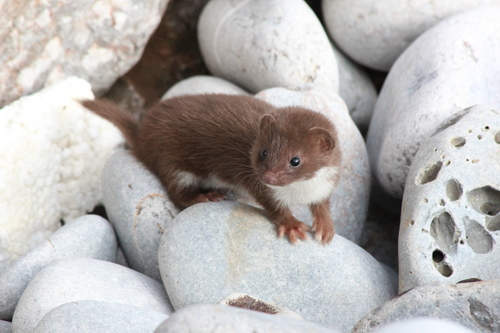
Least Weasel
The least weasel, Mustela nivalis, is a nimble predator with remarkable adaptability. Sporting a coat that turns white in winter, it excels in stealth. Thriving in various habitats, this diminutive hunter plays a vital ecological role in controlling rodent populations.
1-3 years
Lifespan
28.299999999999997 - 249.5 g
Weight
Length: 11 - 25 cm
Size
Black, White, Tan
Color
1-2 years
Age of Sexual Maturity
8 weeks
Age of Weaning
15 mph
Top Speed
Least Concern
Conservation Status
Stable
Population Trend
Characteristics
Mustela nivalis, commonly known as the least weasel, is the smallest member of the weasel family. It has a slender body, short legs, and a tail typically shorter than its body length. Its fur changes from brown in summer to white in winter, aiding in camouflage. Least weasels are found in diverse habitats including grasslands, forests, and even urban areas, primarily across Europe, Asia, and North America. They are known for their agility and hunting prowess, capable of taking down prey several times their size.
Distribution Range of the Least Weasel
Mustela nivalis, commonly known as the least weasel, is native to a wide range of regions across the Northern Hemisphere. Its geographical distribution includes parts of Europe, Asia, and North America. Specifically, it is found throughout most of Europe, extending from the British Isles and Scandinavia in the north to the Mediterranean in the south, and from the Iberian Peninsula in the west to the Ural Mountains in the east. In Asia, its range extends across Russia and into parts of Mongolia, China, and Japan. In North America, the species is present in parts of Canada and the northern United States.
Least Weasel's Habitat
Environmental Conditions
The least weasel inhabits a variety of environmental conditions, reflecting its adaptability. It typically resides in temperate regions but can also be found in subarctic and arctic zones. The species is versatile in its habitat preferences, occupying areas such as open fields, grasslands, woodlands, and even human-altered landscapes like farmlands and gardens. The least weasel prefers environments with dense cover, such as tall grasses or shrubs, which provide protection and hunting grounds.
Ecological Niche
Mustela nivalis is a carnivorous mammal that plays a crucial role in its ecosystem as a predator of small rodents. Its ecological niche involves controlling the populations of mice and voles, which are its primary prey. This dietary preference allows the least weasel to thrive in various habitats where these small mammals are abundant. The species is well-adapted to hunting in narrow burrows and crevices, aided by its slender, elongated body.
Copyright @ Nature Style Limited. All Rights Reserved.
 English
English